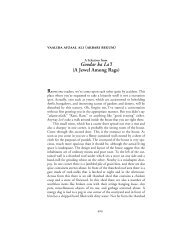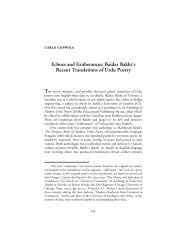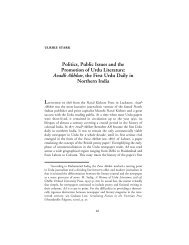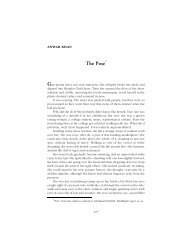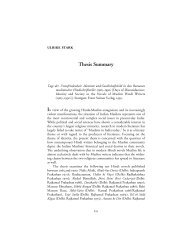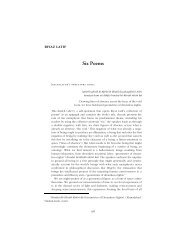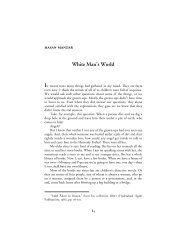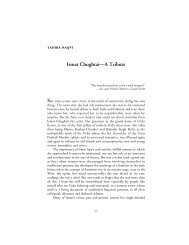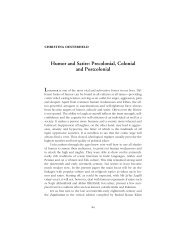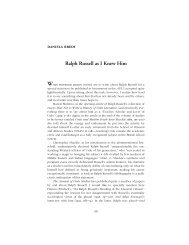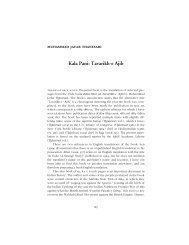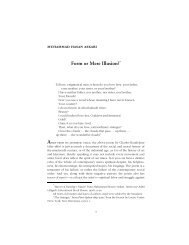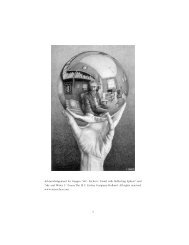Delhi College and Urdu* - MINDS@UW Home
Delhi College and Urdu* - MINDS@UW Home
Delhi College and Urdu* - MINDS@UW Home
Create successful ePaper yourself
Turn your PDF publications into a flip-book with our unique Google optimized e-Paper software.
128 • THE ANNUAL OF URDU STUDIESern philosophy. There are several reasons for this that have little or nothingto do with religious prejudice or cultural resistance. The main reasonwas that in <strong>Delhi</strong> at that time, a knowledge of English was not a requirementfor government service. Even after Persian was disestablished in themid-1830s, Urdu was officially used in the local courts. Knowledge ofPersian remained the mark of a man of culture, Urdu the language ofeveryday discourse <strong>and</strong>, increasingly, of government <strong>and</strong> public business.Hence a traditional literary education, plus—to be sure—some personalconnections, were sufficient to gain access to government service. Many<strong>Delhi</strong> <strong>College</strong> students, of whatever religion, were willing to learn tospeak some English, if only as a useful means of communication withtheir rulers. If they pursued literary studies, however, they usually did soin the classical languages of Arabic, Persian, <strong>and</strong> Sanskrit.The curriculum at the college shows that the distinction betweenoriental <strong>and</strong> western learning, while maintained organizationally, was lessclear in practice. Indeed, Boutros hoped to make the annual exams comparablein all subjects—except literature—for the students of bothsections of the college. In the oriental madrasa, senior Arabic students ofMaul≥n≥ Maml∑k ‘Alµ were examined on the Dµv≥n of Mutanabbµ, theMaq≥m≥t of ƒarµrµ, <strong>and</strong> excerpts from Alf Laila (The 1001 Nights), ongrammar <strong>and</strong> composition, <strong>and</strong> on their ability to translate Arabic worksinto Urdu (some of which were then published by the TranslationSociety). Students of Persian studying with Maulvµ Im≥m Bakhsh were examinedon the Insh≥’-e Abu ’l-Fa¤l (a manual of correspondence by theMughal historian), the Sik<strong>and</strong>arn≥ma of Ni ≥mµ (tales of Alex<strong>and</strong>er theGreat), plus grammar, composition, <strong>and</strong> translation into Urdu. Inhistory, they read the T≥rµkh-r Tµm∑rµ (History of Timur), in geography,the Mir’atu ’l-Aq≥lµm (A Reflection of the Climes), both in Urdu. In law,Sunni students read the Hid≥ya (a digest of ƒanafµ fiqh); <strong>and</strong> Shi‘as readSharµ‘atu ’l-Isl≥m <strong>and</strong> Naf√atu ’l-∂m≥n(digests of Shi‘a fiqh). In math, themadrasa students studied the Urdu translation of Brown’s arithmetic, ast<strong>and</strong>ard textbook of the day, <strong>and</strong> in geometry—predictably—Euclid. Inthe Sanskrit classes, an experiment to teach math via the Lilavati (a mathematicalportion of Bhaskara’s Siddhanta Shiromani) did not succeed.Students complained that it was too difficult to learn both Bhaskara’sSanskrit <strong>and</strong> math simultaneously; the teachers agreed <strong>and</strong> turned toThe Politics of the Heavens in India” (draft in author’s possession, courtesy ofC.A. Bayly).



